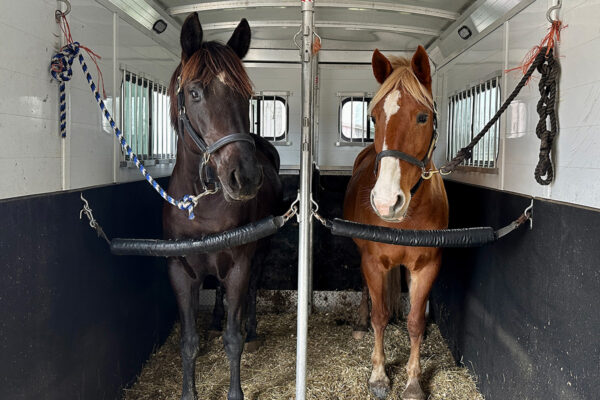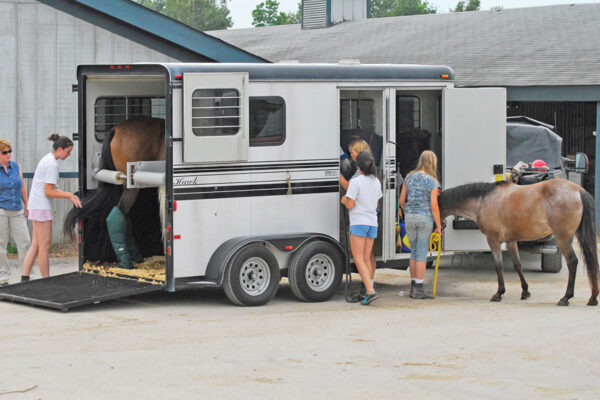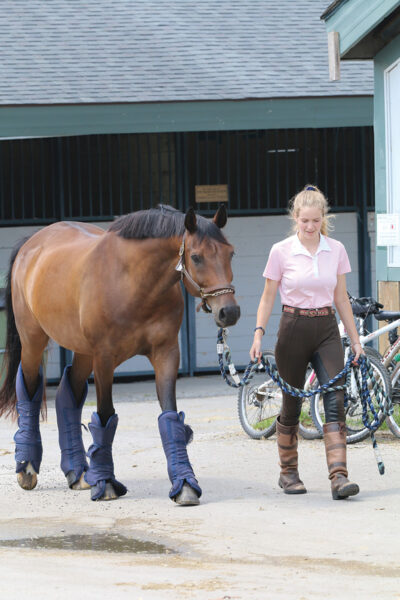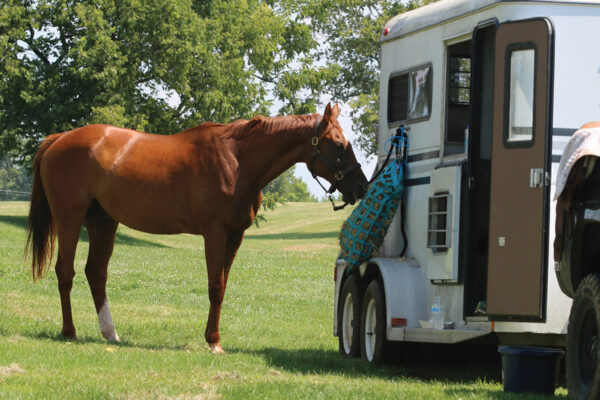This article about horse trailer safety is brought to you in partnership with The United States Pony Clubs, Inc. Join Pony Club for more lessons like this! Find a Pony Club or Pony Club Riding Center near you and learn more at www.ponyclub.org.

If you have a horse or pony, at some point you and a trusted adult will probably need to trailer him— whether in your own trailer or a friend’s. For instance, you may need to take your horse to a veterinarian or a show or clinic, or you may plan to trail ride somewhere away from your home barn. As such a key part of the equestrian lifestyle, horse trailer safety is crucial.
Make sure that the person hauling your horse is a safe, responsible driver. It’s best to have more than one person haul a horse. Having someone along who can help in case of trouble with the horse, trailer, or tow vehicle can make all the difference in how a problem is handled and can make handling an emergency much easier and safer.

A horse trailer and the vehicle that tows it must be in good mechanical condition. This requires regular maintenance. A trusted adult should do a safety check of the truck and trailer every time you need to haul your horse or pony, and it’s a good thing for every young rider to learn how to do.
Be sure to check out our trailer packing list and horse trailer/tow-vehicle pre-trip checklist.
Travel Prep
The right equipment can keep your horse or pony safe while traveling. Leg protection is a must. Shipping boots are quick and easy to apply. Some styles offer more protection than others. Keep in mind shipping boots are not breathable and not recommended for long-distance travel in hot weather.

Another leg-protection option is a stable or standing bandage with bell boots, which offers more support and is more breathable than a shipping boot. Bell boots help protect the bulbs of the heels and coronary band, which are common areas injured during trailering.
To protect the poll, consider using a head bumper for horses with a high head carriage or who are known to throw their head upward in a trailer.
A stable sheet or lightweight blanket can offer protection from drafts. However, it’s important to pay attention to the weather and adjust the clothing for the horse’s comfort. Over-blanketing may cause your horse to sweat or get too warm in an enclosed trailer. Proper ventilation is very important.
Horse Trailer Loading/Unloading Safety
Most horses travel well if they have been properly introduced to the trailer and have not had a prior scary trailering experience. If not, you may need help from a trainer to help him learn to trailer calmly.
Before a trip, be sure that your horse will quietly load, unload, and ride in the trailer. Travel with someone who is experienced in handling and loading horses in the trailer so if your horse is not an easy loader, you have someone who can help you.
Loading always goes more smoothly if you are prepared:
◆ Cover the trailer floor with a layer of shavings or other bedding.
◆ Ensure the driver parks on as level of a surface as possible, especially if you are using a ramp. Open all doors and windows for good ventilation and to allow as much light inside as possible. (If loading at night, lights may make loading easier.)
◆ In a side-by-side trailer, put the heavier horse on the driver’s side. In a slant-load trailer, put the heavier horse in the stall over the axle. If hauling only one horse, put him on the driver’s side or in the stall over the axle of the slant-load trailer.
◆ If you plan to give your horse hay to keep him happy, make sure to tie it high enough (chest height or above) so there is no way he can get a foot through the hay net or hay bag.

Steps to loading a horse safely:
◆ Be quiet, patient, and confident during loading. Always allow extra time. If you rush and worry about being late, horses will pick up on your stress and can become upset and difficult to load.
◆ Lead the horse straight forward on to the trailer. If your trailer has chest bars, you may walk in ahead of him and slip under the chest bar as he follows you in. If your trailer is the kind with a solid front, your horse should be trained to step or walk on to the trailer as you stand beside the door. It is not safe to walk into a closed trailer stall with a horse.
◆ Once loaded, have someone fasten the tail bar or back door behind your horse before you tie him. Caution: Never tie a horse’s head when the tail bar or back door is open behind him. This can cause him to pull back and panic.
◆ The horse should be tied with a quick-release knot or a special trailer tie with a quick-release snap. The tie rope should be long enough so he can reach his hay net, but not so long that he can turn his head around or nip at his neighbor.
Steps to unloading a horse safely:
◆ Again, ensure you are on level ground. Avoid unloading on the highway or another area with busy traffic, on slippery ground, or too close to anything the horse could bump into.
◆ Caution: Always untie your horse’s head before you lower the ramp, open the back door, or unfasten the tail bar.
◆ When ready to unload, you helper should unfasten the tail bar. Back your horse out slowly in a straight line so he doesn’t step off the side of the ramp by mistake.
This article about horse trailer safety appeared in the July/August 2022 issue of Young Rider magazine. Click here to subscribe!


